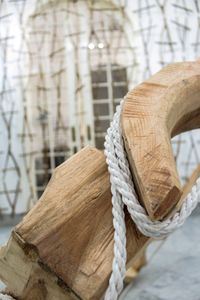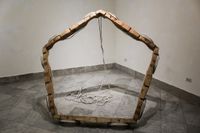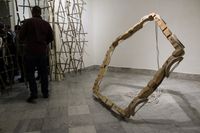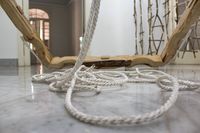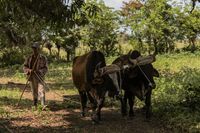VOLUNTAD
WILL
Installation
2019
In collaboration with Dibel Roque Bolaño
1.90W x 1.90H x 0.15Mtr
Bullocks yoke and rope
Voluntad, has 5 yokes in pentagonal form, hung from a single point in the direction of the sky. United as a single object, a single load and a single mooring structure, they submit from the visuality in a single act of faith. In this case the situation is constructed by giving this practical object (by the question of use) a "temporary" decorative value almost of worship that generates a dialogue about power and gentleness. Our yoke takes the number of man, the microcosm, hence we start from a language structure of power itself the peasant community. Its imposition of forces and evident control of the surrounding environment as a tool.
The yoke, symbol of forced animal labor, turns the man who accepts it into a meek ox. To subjugate and punish is a constant in the life of man. This is a problem of political power that is contained in social systems, it is imposed on the community as an object of "invisible" worship, it does not have a god to worship as religion would have it instead, it has a series of figures that are perpetuated or changed and whose images remain in the collective memory of individuals, bordering on the ridiculous in some cases to really turn these iconographies into an obligatory cult to entertain the dominant power. The obeisance comes from the lowest layers, with great force. The smaller the social link in which one is standing, the greater the obeisance can be, as a matter of accumulating interests and benefits. The will is relative, when the cult is rendered constantly in the small activities and decisions of life.
The peasant economy is related to a somewhat conservative idea based on the supposed ignorance of the society that surrounds it. To a certain extent, this naivety allows the dominant powers to operate more effectively with these groups of individuals.
Social power imposes a relationship that could be catalogued as a training of the masses. Just like the animal and its master, an indoctrination is implemented in which individuals adopt a series of behaviors, customs and ways of acting that at first glance seem completely natural. But the truth is that they are conditioned by processes of social interaction, which in turn are determined by the different human powers.
The way in which the social strata project themselves depends to a large extent on the domains to which they are subjected. The social forces close to the center of absolute power receive as much attention as those that are "isolated" or difficult to access physically. Herding reaches everyone, with individual attention, but it is nonetheless a technique of massification and registration.
The instruments of training and cultivation of agricultural areas in Cuba (and in some other underdeveloped countries) have an archaic technological visuality. Five hundred years of tradition and the mechanisms are still the same. The meekness they provoke makes us think of these objects as an image that is perpetuated not only for the animals, but also for the human mass that populates the whole country.
The elements of domination of the Cuban countryside remain to this day very similar to those used a couple of hundred years ago to subdue "races". It may be that in a humane way they do not directly subdue the other with evident physical violence. But symbolic violence is permeating the relationships of individuals with their social systems, and more so when these struggles are subject to the idea that work should be under a unifying element and equal possibilities for all.
